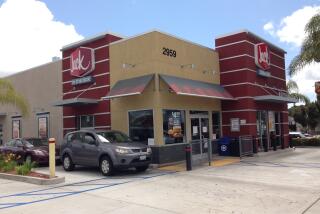Foodmaker Still Struggles to Digest Leveraged Buy-Out
- Share via
SAN DIEGO — Leveraged buy-outs can be expensive. Very expensive. Just ask the management group that purchased San Diego-based Foodmaker from Ralston Purina in September, 1985.
Total debt of Foodmaker, parent of the Jack in the Box fast food chain, reached $406 million as of Dec. 21.
And paying off those loans translated into a working capital deficit of nearly $110 million, despite dramatic cost cutting and an increase in net profit.
Now, only 16 months after spinning off from Ralston Purina, Foodmaker wants to become a public company, and is trying to offer its common stock for $12 to $15 per share.
However, using a very conservative, Securities and Exchange Commission-required formula that only includes tangible assets such as buildings and other “brick and mortar” items, Foodmaker has a negative book value--or an excess of liabilities over those assets--of $20.8 million, or $2.45 per share. The figures are contained in Foodmaker’s preliminary prospectus filed Friday with the SEC in support of the planned public stock offering of 4 million shares. The company also disclosed in its prospectus that it agreed earlier this month to sell--and then lease back--115 Jack in the Box restaurant sites for about $70 million. (There are 849 Jack in the Box outlets; 655 of them are company-operated and 194 are franchises.)
Proceeds from both the offering, which is expected to be completed late next month, and the sale-leaseback will be used to pay off Foodmaker’s debt.
Using generally accepted accounting procedures, Foodmaker’s per-share book value is in the black--$5.44, and will approach $7.79 per share, assuming a $15-per-share offering price, said Charles W. Duddles, Foodmaker’s chief financial officer.
According to the prospectus and using the “tangible” book value calculation, Foodmaker’s per-share book value will climb to only $3.14 after the offering. That figure does not include underwriting expenses and commissions, however.
Foodmaker management bought company stock for $4.50 per share during the leveraged buy-out in 1985, and continues to have options to buy 513,750 more shares for $4.50 per share, according to the prospectus.
After the offering, company management will own nearly 68% of Foodmaker stock but will have contributed only about 39% of total capital, according to the prospectus.
Foodmaker has nearly 8.5 million shares outstanding.
More than $76 million in company debt is listed as “current,” which means that the loans are due within 12 months. It is that debt that will be paid off with the offering and sale-leaseback proceeds.
Duddles acknowledged that “it would have been tough to make payments” on that current debt if management had not decided to take Foodmaker public. The debt probably would have been refinanced, but management determined that it wanted to “put more equity into the company” and pay off the loans, Duddles said.
Foodmaker management embarked on a large cost-cutting campaign after the buy-out, which is reflected in the stock offering prospectus.
For the year ended Sept. 28, 1986, Foodmaker revenues dropped 7.3% to nearly $494 million. But net earnings rose 68% to $9.2 million.
The earnings include depreciation and amortization expenses related to the leveraged buy-out, which cut deeply into profits. Assuming that the leveraged buy-out had not occurred, for example, Foodmaker would have reported profits of $26.4 million in 1985.
In 1984, the company reported earnings of $31.2 million.
More to Read
Inside the business of entertainment
The Wide Shot brings you news, analysis and insights on everything from streaming wars to production — and what it all means for the future.
You may occasionally receive promotional content from the Los Angeles Times.










